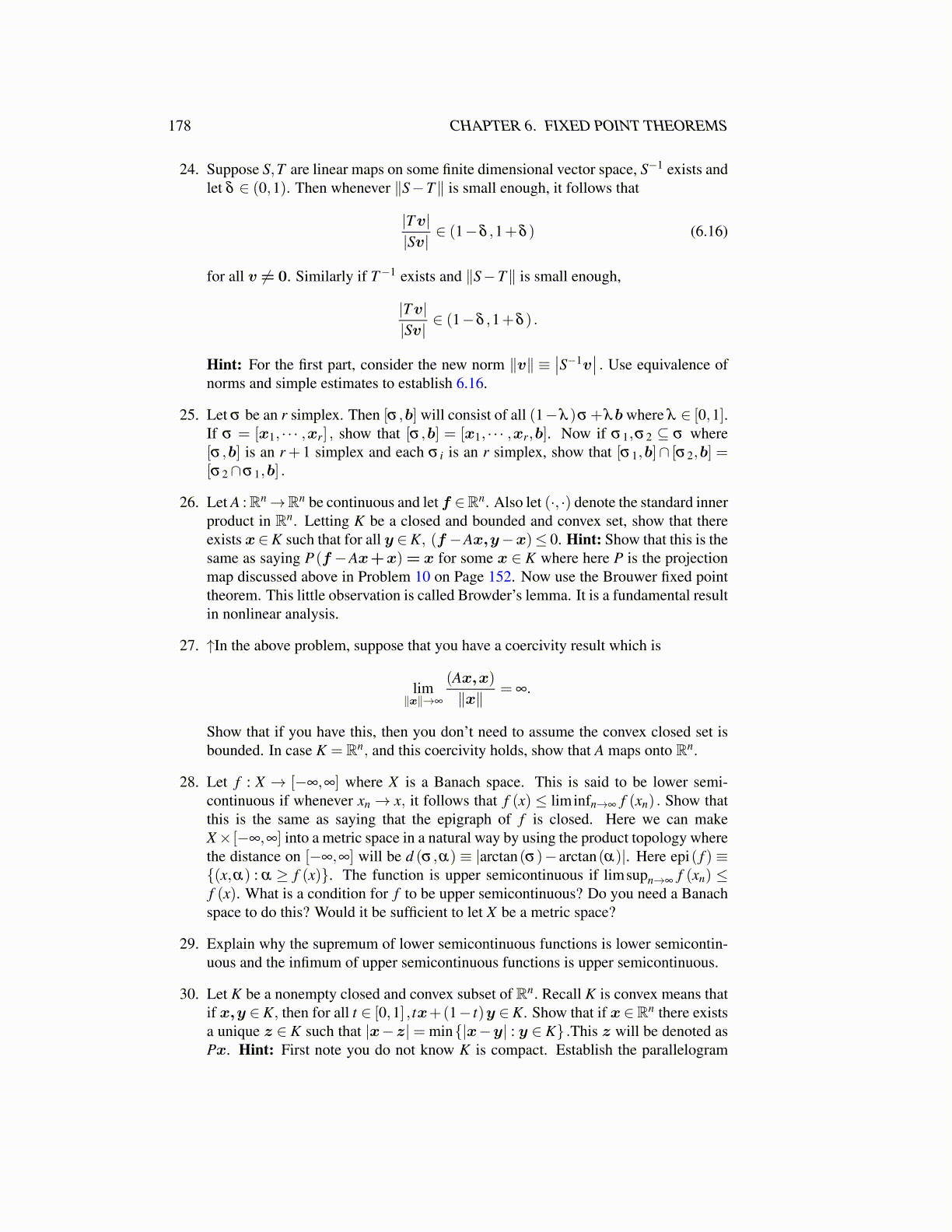
178 CHAPTER 6. FIXED POINT THEOREMS
24. Suppose S,T are linear maps on some finite dimensional vector space, S−1 exists andlet δ ∈ (0,1). Then whenever ∥S−T∥ is small enough, it follows that
|Tv||Sv|
∈ (1−δ ,1+δ ) (6.16)
for all v ̸= 0. Similarly if T−1 exists and ∥S−T∥ is small enough,
|Tv||Sv|
∈ (1−δ ,1+δ ) .
Hint: For the first part, consider the new norm ∥v∥ ≡∣∣S−1v
∣∣ . Use equivalence ofnorms and simple estimates to establish 6.16.
25. Let σ be an r simplex. Then [σ ,b] will consist of all (1−λ )σ +λb where λ ∈ [0,1].If σ = [x1, · · · ,xr] , show that [σ ,b] = [x1, · · · ,xr,b]. Now if σ1,σ2 ⊆ σ where[σ ,b] is an r+ 1 simplex and each σ i is an r simplex, show that [σ1,b]∩ [σ2,b] =[σ2∩σ1,b] .
26. Let A :Rn→Rn be continuous and let f ∈Rn. Also let (·, ·) denote the standard innerproduct in Rn. Letting K be a closed and bounded and convex set, show that thereexists x∈K such that for all y ∈K, (f −Ax,y−x)≤ 0. Hint: Show that this is thesame as saying P(f −Ax+x)= x for some x ∈ K where here P is the projectionmap discussed above in Problem 10 on Page 152. Now use the Brouwer fixed pointtheorem. This little observation is called Browder’s lemma. It is a fundamental resultin nonlinear analysis.
27. ↑In the above problem, suppose that you have a coercivity result which is
lim∥x∥→∞
(Ax,x)∥x∥
= ∞.
Show that if you have this, then you don’t need to assume the convex closed set isbounded. In case K = Rn, and this coercivity holds, show that A maps onto Rn.
28. Let f : X → [−∞,∞] where X is a Banach space. This is said to be lower semi-continuous if whenever xn → x, it follows that f (x) ≤ liminfn→∞ f (xn) . Show thatthis is the same as saying that the epigraph of f is closed. Here we can makeX× [−∞,∞] into a metric space in a natural way by using the product topology wherethe distance on [−∞,∞] will be d (σ ,α) ≡ |arctan(σ)− arctan(α)|. Here epi( f ) ≡{(x,α) : α ≥ f (x)}. The function is upper semicontinuous if limsupn→∞ f (xn) ≤f (x). What is a condition for f to be upper semicontinuous? Do you need a Banachspace to do this? Would it be sufficient to let X be a metric space?
29. Explain why the supremum of lower semicontinuous functions is lower semicontin-uous and the infimum of upper semicontinuous functions is upper semicontinuous.
30. Let K be a nonempty closed and convex subset of Rn. Recall K is convex means thatif x,y ∈ K, then for all t ∈ [0,1] , tx+(1− t)y ∈ K. Show that if x ∈Rn there existsa unique z ∈ K such that |x−z|= min{|x−y| : y ∈ K} .This z will be denoted asPx. Hint: First note you do not know K is compact. Establish the parallelogram